17 October, 2004
A trip to Cape Royds
Since Sunday is our day off, we all went north about 25 miles in the Pisten Bully to Cape Royds to check out the potential for diving. The scientists want to dive at this site because it is a major rookery (breeding and nesting spot) for Adelie penguins. They want to see how runoff of penguin guano (poop) affects the benthic community in this location.
This gave us an excellent tour of the eastern side of part of McMurdo Sound. We left the station and drove out onto the ice, then took a sharp right and just followed the ice road. The ice road is similar in idea to a paved road, except it's just a path on ice, and its sides are marked with flags, similar to the way a channel for ships or boats is marked with buoys.
We passed two of the research dive sites - Cinder Cones and Turtle Rock. We also passed the Erebus Ice Tongue, a long, narrow glacier that comes off Mount Erebus. Glaciers form when snow is compressed at a fairly high elevation, eventually becoming so compacted that it is no longer snow, but ice. The end of a glacier often resembles a wall of ice. Check out the pictures below to see the difference between the ends of the Erebus Ice Tongue and the Barne Glacier.
We passed some islands that are the rims of ancient volcanos. In the shadow of one of them, Big Razorback, two seal researchers are camped. We saw a few seals at a distance, hauled out on the ice and soaking up some rays.
We also passed Cape Evans, where the famous hut of explorer Robert Scott is located. The hut near McMurdo is also Scott's hut, but from an earlier expedition. The one at Cape Evans is the one Scott was trying to reach when he died after reaching the South Pole in 1911.
When traveling on the sea ice, it's important to be very careful to watch for cracks. If a part of the ice is in question, it must be inspected and sometimes drilled to see how thick the ice is before a vehicle tries to cross it. A number of vehicles have fallen into cracks in the ice over the years!
It takes over an hour to get to Cape Royds in the Pisten Bully. After parking the vehicle and walking over a hill, we saw that the penguins are not here. In recent years, the ice has not been "going out" as it normally does, meaning that what is usually open water is still ice, and the ice sheet extends much farther out in the sound. Part of this is caused by the presence of a large iceberg called B-15, which broke off the glacier in 2000 as been blocking the ice from going out. The penguins need some open water to travel to their rookery and scientists wonder if they will come this year. Iceberg B-15 is the size of Massachusetts and Connecticut combined, and, if it were melted, could provide all the water for the entire United States for the next 10 years!
So the only penguins we saw were dead ones that had not survived previous years. There is another hut at Cape Royd's, this one built by Ernest Shackleton, another British polar explorer, who sought to reach the South Pole.
We went down onto the ice in search of a crack that might provide a starting place for a dive hole. It's much easier to make a dive hole if you have a natural head start. Andrew and Bob found such a crack, complete with a snuffling seal coming up to breathe. While this site was not near enough to the penguin colony to be exactly right, the hole was chopped out enough to allow a vertical plankton tow.
Cape Royds was very beautiful, with its dark volcanic rocks, pressure ridges that form when ice is pushed against other ice or land, and snow with swirls of dust. The light shining through some of the ice makes a luminous blue color that is gorgeous. It was a great trip.
The wind started coming up, however - it can really get blowing across the ice - so we headed for home.
Jennifer was totally excited when we got back to the lab and she put the plankton sample under the microscope, finding diatoms, copepods, a veliger larva of an echinoderm (such as a sea star or a sea urchin), and a "mystery" plankton that turned out to be the larva of a polychaete worm (a little like our clam worms).
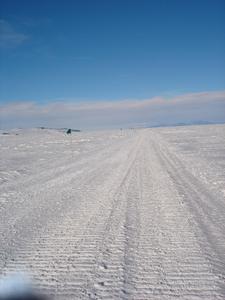
1. The ice road.

2. The end of the Erebus Ice Tongue Glacier.

3. The end of Barne Glacier
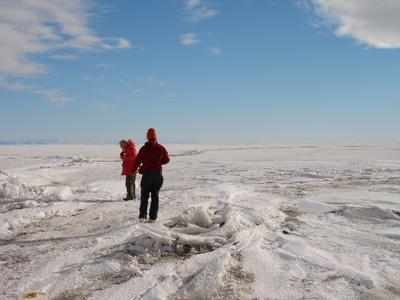
4. Stacy and Bob check out cracks in the sea ice.
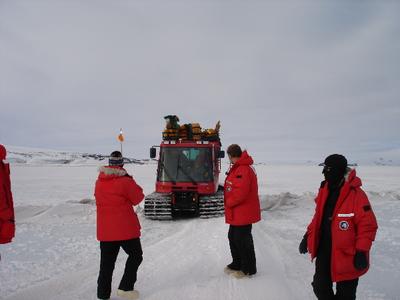
5. After determining that the ice is safe, Stacy brings the Pisten Bully across the crack.
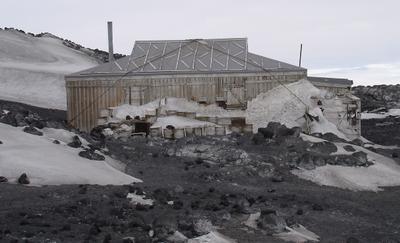
6. Shackleton's hut, built in 1908 for the Nimrod expedition.
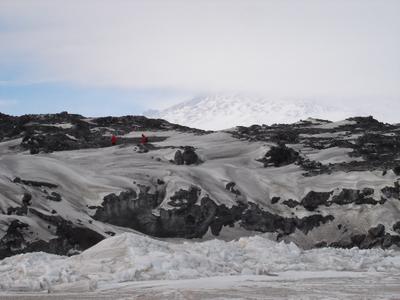
7. Jennifer and Mike look from above for cracks that could be possible dive hole locations.

8. Chopping a hole to lower the plankton net.
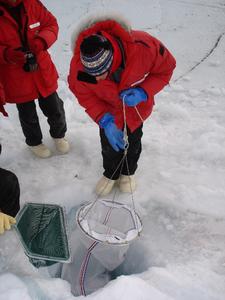
9. After the hole has been cleared of ice, the plankton net can be lowered into the water.
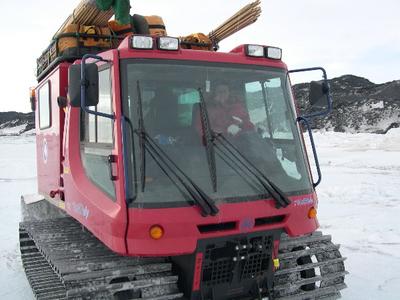
10. Who gave her a license?!
Contact the TEA in the field at
.
If you cannot connect through your browser, copy the
TEA's e-mail address in the "To:" line of
your favorite e-mail package.
|
